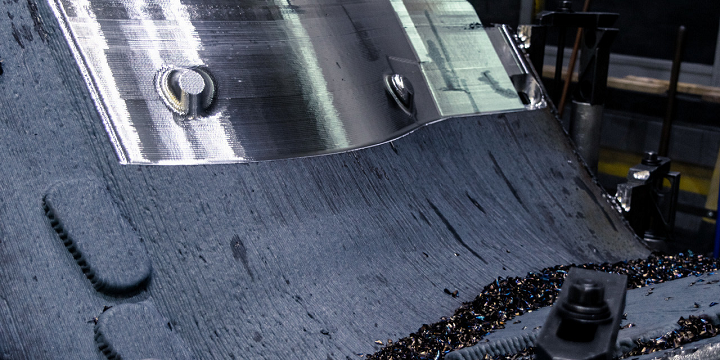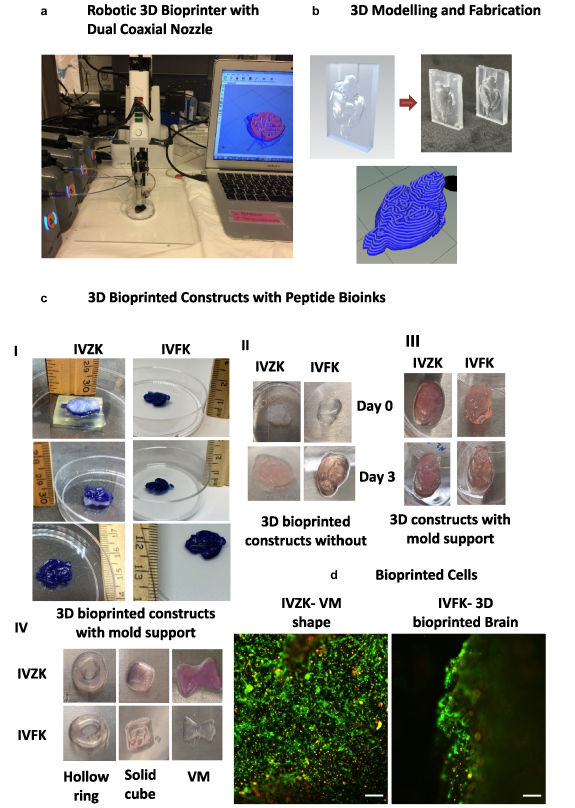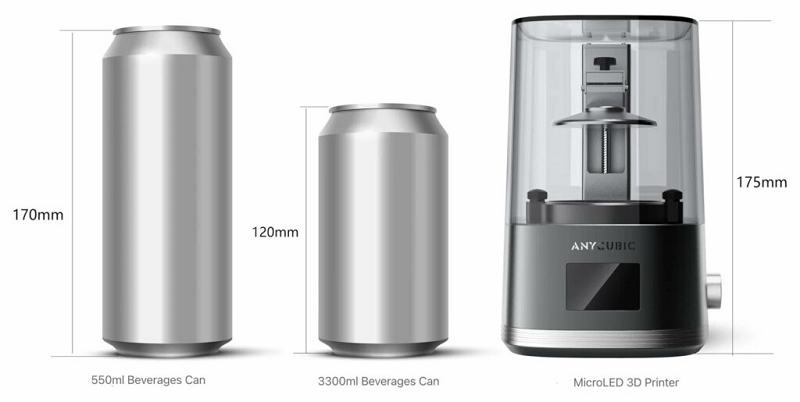In today’s 3D Printing News Briefs, EPLUS3D is offering metal 3D printing as an option for flexible manufacturing of sheet metal. Anycubic is working with a MicroLED display manufacturer to develop a consumer-grade MicroLED 3D printer, and Baker Industries and Lincoln Electric Additive Solutions are partnering with on a feasibility study focused on WAAM technology. Finally, in research, a team from Georgia Tech and UMass Amherst are 3D printing an ultra-strong, ductile, high-performance nanostructured alloy, and researchers from Saudi Arabia developed a Parkinson’s disease model made up of 3D bioprinted dopaminergic neurons inside a biomimetic peptide scaffold.
EPLUS3D Offering Metal AM for Sheet Metal Manufacturing
EPLUS3D offers advanced metal 3D printing solutions, including its EP-M260 PBF platform, and the applications include rapid prototyping, medical equipment, product customization, and sheet metal fabrication, which is often used in industries including automotive, electrical, telecommunications, and others. Sheet metal is a skeleton that’s used to support and shape products, and it’s becoming an important step in developing new products trending towards diversified yet low volume production. Typically, a punching die is used in conventional sheet metal manufacturing, but tooling for these ties is costly and time-consuming. Often, a combination of laser cutting and CNC bending is used to manufacture sheet metal in small lots, which takes less time and money, but unfortunately, laser cutting only works for molding and hole cutting, and bending can only be used for flat structures.
The company provided two application examples for using 3D printing for sheet metal manufacturing, with the first being a car seat manufacturing company that’s a main contractor of car factories like Ford and Chang’an. The company is unveiling a new car seat set with 78 pieces, but sheet metal parts can’t be created because their tools are still in progress. Because most of the parts have bumps and ribs, it’s not possible to mold them with CNC bending or laser cutting, so the company contacted EPLUS3D. 316L stainless steel was chosen to print the seat plate parts, and it took only 7 days to print everything and polish the surfaces using grinding. The other case is a machine manufacturer looking to produce a silencer, made of four components with a uniform shell thickness of .73 mm. The sheet metal structure is complex, and can’t be manufactured using cutting, bending, or milling, so the only options were punching and 3D printing. Because of the expense of producing a punching tool, EPLUS3D printed the necessary metal sheets in just three days.
Anycubic, JBD Developing Consumer MicroLED 3D Printer
3D printer manufacturer Anycubic and Jade Bird Display (JBD), which manufactures MicroLED displays, are working together to create what they say is the first consumer-grade MicroLED 3D printer, with plans to unveil it at the TCT Asia Exhibition and the CIOE Expo. With a working name of J1, the printer is only about 175 mm high, making it just a little taller than a regular 550 ml beverage can, and includes a compact, long-lasting light module and JBD’s UV MicroLED Display, made with the company’s semiconductor hybrid integration technology. The J1 MicroLED printer is said to be able to achieve very small details with its 0.13″ UV light engine, so it can print high-precision prototype parts for medicine, aerospace, and other fields that require high accuracy.
“We have been following the concept of developing accessible, practical, and innovative products. The cooperation with JBD demonstrates our creativity in product development and the progress that we have made in producing portable 3D printers. It will enable us to go far in unleashing people’s creativity and making people enjoy the freedom in creation,” an Anycubic spokesperson said.
LEAS, Baker Industries Join GA-ASI in WAAM Feasibility Study

GA-ASI’s 3D printed steel layup tool being CNC machined at Baker Industries, a Lincoln Electric Company, in Macomb, Michigan
Lincoln Electric Additive Solutions (LEAS) and Baker Industries, a Lincoln Electric Company, have begun a strategic R&D relationship with General Atomics Aeronautical Systems, Inc. (GA-ASI), focused on the feasibility of using wire arc additive manufacturing (WAAM) to produce steel layup tooling for manufacturing composite lamination of its unmanned aerial systems (UAS). GA-USI needed a process to create complex tooling that’s accurate, repeatable, vacuum-tight, and rigid enough to hold up under the fatigue and stress resulting from repetitive autoclave cycles. Engineering teams from the companies collaboratively reviewed several tool geometries and requirements, and decided that WAAM, and its ability to quickly produce large, complex components, could be the best option. GA-USI is still qualifying the process, but has had preliminary success in reaching production-level use, and the first tool produced using WAAM passed its initial assessments.
Mike Wangelin, Business Development Manager at Lincoln Electric Additive Solutions and Baker Industries, said, “Our turnaround time can be significantly quicker than larger job shops, and we can usually ramp up production quickly to combat fluctuations in customer demand.”
Researchers 3D Print High-Performance, Ultra-Strong, Ductile Nanostructured Alloy

UMass Amherst PhD student Jie Ren holds a miniature heatsink fan, one of the 3D printed high entropy alloy components made in Wen Chen’s lab. The microstructure’s atomic rearrangement gives rise to ultrahigh strength as well as enhanced ductility, research by UMass Amherst and Georgia Tech shows.
Researchers from University of Massachusetts Amherst and Georgia Institute of Technology, along with partners from Texas A&M University, UCLA, Rice University, Oak Ridge National Laboratory, and Lawrence Livermore National Laboratory, have 3D printed a dual-phase, high-performance, nanostructured high entropy alloy, or HEA, that has much higher ductility and strength than other AM materials. This could result in higher-performing components for aerospace, energy, automotive, and medical applications. HEAs are made of five or more elements in near-equal proportions, which gives them the unique ability to create an almost infinite number of combinations for alloy design. But until now, there hasn’t been much research into the combined benefits of 3D printing and HEAs for achieving novel properties. Wen Chen, assistant professor of mechanical and industrial engineering at UMass, and his team in the Multiscale Materials and Manufacturing Laboratory, combined LPBF with an HEA, which resulted in a very unique microstructure made of alternating layers called face-centered cubic (FCC) and body-centered cubic (BCC) nanolamellar structures embedded into microscale eutectic colonies at random. Chen explained that the “microstructure’s atomic rearrangement” resulted in nearly triple the strength, as well as increased ductility, of conventional metal casting. Ting Zhu, professor of mechanical engineering at Georgia Tech, and his group worked on computational modeling for the research, and developed dual-phase crystal plasticity computational models to better understand the roles of the FCC and BCC nanolamellar structures, and how they give the material extra ductility and strength.
Jie Ren, Chen’s PhD student and first author of the paper, said, “The ability to produce strong and ductile HEAs means that these 3D printed materials are more robust in resisting applied deformation, which is important for lightweight structural design for enhanced mechanical efficiency and energy saving.”
Researchers Develop Parkinson’s Model of 3D Bioprinted Neurons

3D bioprinting of vm DA and vm non-DA neuronal model. (a) Robotic 3D bioprinter with dual coaxial nozzle. (b) Modeling and fabrication of mouse brain mold and printing g-code (c, I) 3D-printed mouse brain model with mold support. Bromophenol blue was used during printing to enhance visualization of the construct’s details. (c, II) 3D bioprinted constructs without mold support, and (c, III) 3D constructs made with mouse brain mold support at a scale of 1:1. (c, IV) Vm DA and vm non-DA neurons 3D-bioprinted in form of a hollow ring, a solid cube, and VM-inspired shapes. (d) Confocal images of TUJ1+ and TH+ VM neurons in 3D-bioprinted VM-inspired shape and mouse brain shape at day 3 of culture.
Finally, researchers from King Abdullah University of Science and Technology (KAUST), Taif University, and King Abdulaziz University (KAU) in Saudi Arabia published a paper on “A Parkinson’s disease model composed of 3D bioprinted dopaminergic neurons within a biomimetic peptide scaffold.” Parkinson’s disease, a progressive neurological disorder, is associated with lost dopaminergic (DA) neurons in the substantia nigra, and affects the patient’s movement. The process is still not completely understood, and in order to gain more knowledge, efficient in vitro 3D models are needed that can summarize complex organs, like the brain. But neurons are extremely complex, so it’s difficult to find good biomaterials to accommodate them in research efforts. This research team used ultrashort self-assembling tetrapeptide scaffolds to create functional DA neuronal 3D models—biocompatible with both primary mouse embryonic DA neurons and human DA neurons derived from human embryonic stem cells—in order to offer “a platform for studies of the pathogenesis of PD and other neurodegenerative disorders that may lead to better understanding and more efficient treatment strategies.”
“DA neurons encapsulated in these scaffolds responded to 6-hydroxydopamine, a neurotoxin that selectively induces loss of DA neurons. Using multi-electrode arrays, we recorded spontaneous activity in DA neurons encapsulated within these 3D peptide scaffolds for more than 1 month without decrease of signal intensity. Additionally, vascularization of our 3D models in a co-culture with endothelial cells greatly promoted neurite outgrowth, leading to denser network formation. This increase of neuronal networks through vascularization was observed for both primary mouse DA and cortical neurons. Furthermore, we present a 3D bioprinted model of DA neurons inspired by the mouse brain and created with an extrusion-based 3D robotic bioprinting system that was developed during previous studies and is optimized with time-dependent pulsing by microfluidic pumps. We employed a hybrid fabrication strategy that relies on an external mold of the mouse brain construct that complements the shape and size of the desired bioprinted model to offer better support during printing.”
Subscribe to Our Email Newsletter
Stay up-to-date on all the latest news from the 3D printing industry and receive information and offers from third party vendors.
You May Also Like
Profiling a Construction 3D Printing Pioneer: US Army Corps of Engineers’ Megan Kreiger
The world of construction 3D printing is still so new that the true experts can probably be counted on two hands. Among them is Megan Kreiger, Portfolio Manager of Additive...
US Army Corps of Engineers Taps Lincoln Electric & Eaton for Largest 3D Printed US Civil Works Part
The Soo Locks sit on the US-Canadian border, enabling maritime travel between Lake Superior and Lake Huron, from which ships can reach the rest of the Great Lakes. Crafts carrying...
Construction 3D Printing CEO Reflects on Being Female in Construction
Natalie Wadley, CEO of ChangeMaker3D, could hear the words of her daughter sitting next to her resounding in her head. “Mum, MUM, you’ve won!” Wadley had just won the prestigious...
1Print to Commercialize 3D Printed Coastal Resilience Solutions
1Print, a company that specializes in deploying additive construction (AC) for infrastructure projects, has entered an agreement with the University of Miami (UM) to accelerate commercialization of the SEAHIVE shoreline...































